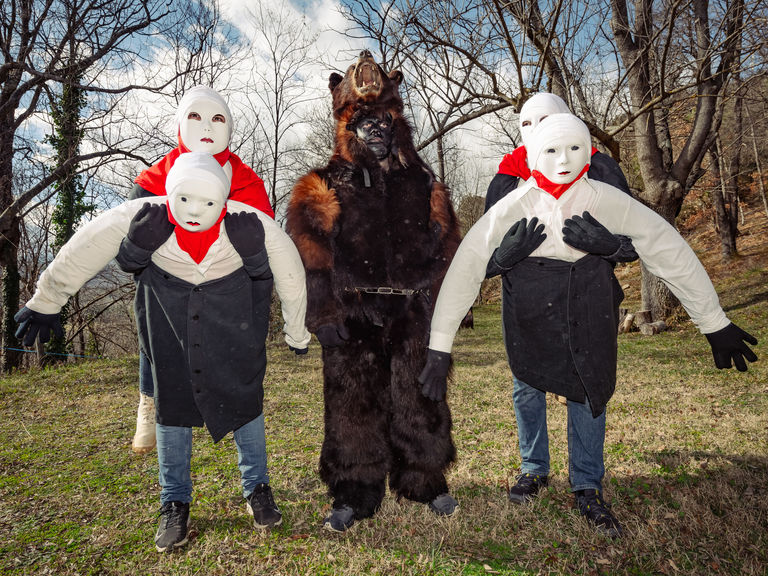Project Detail: Homo Ursus
Contest:
Swiss Storytelling Photo Grant 9th
Brand:
LuganoPhotoDays
Author:
Pierre Banoori
Project Info
Homo Ursus
Research suggests that humans have worshipped bears since palaeolithic times. Early humans may have perceived lone bears -fierce, strong, and able to stand upright- as gods amongst men. Today we are mostly left with tall tales and mythologies. But there are people that still celebrate the bear. Romania has dancing bear festivals every December, while the Ainu in Japan revere the bear as the god of all gods. This reportage is a first chapter of a long-term project. It depicts the Fêtes de l’Ours (bear festivals) in the villages of Arles-sur-Tech, Prats-de-Mollo, and Saint-Laurent-de-Cerdans, in Vallespir (French Catalonia). Rooted in ancient pagan practices, they are major celebrations in which friends and families gather in a playful, theatrical, and violent display of culture. In November 2022 the Fêtes de l’Ours received UNESCO intangible cultural heritage status. However, they have not been immune to the societal changes stemming from our globalised world.
It’s 1pm on a sunny February day. Fort Lagarde in Prats-de-Mollo stands solemnly atop a hill, surrounded by the silent & snow-capped Pyrenees, brushed by a fresh mountain breeze.
A harmonious tranquillity only to be broken by the echoing thunder of gunshots and pluming white clouds. People start running down the hills in a cheery panic.
The bears have been released.
Research suggests that humans have worshipped bears since palaeolithic times.
Early humans may have perceived lone bears -fierce, strong, and able to stand upright- as gods amongst men. Today we are mostly left with tall tales and mythologies. But there are people that still celebrate the bear. Romania has dancing bear festivals every December, while the Ainu in Japan revere the bear as the god of all gods.
While very diverse, many celebrations that worship the bear tiptoe around the story of John the Bear. The myth is based on the abduction of a woman by a bear. Living together in the forest, a child was born. Hairy, strong, and fierce, the child was called John. Endowed with great power, John frees himself and his mother from the bear’s den and goes on a quest. In Homeric fashion, John meets other people and creatures along the way and is faced with herculean tasks. Upon completion, John is accepted into the world of men.
The myth of John the Bear can be found today in folktales and mythologies throughout many parts of Eurasia. However, traces are also found in North and South America.
This reportage is a first chapter of a long-term project. It depicts the Fêtes de l’Ours (bear festivals) in the villages of Arles-sur-Tech, Prats-de-Mollo, and Saint-Laurent-de-Cerdans, in Vallespir (French Catalonia). Rooted in ancient pagan practices, they are major celebrations in which friends and families gather in a playful, theatrical, and violent display of culture.
The origins of these bear festivals can be traced back to the ancient cultures that inhabited the Pyrenees region thousands of years ago. Many of these cultures worshipped bears as powerful symbols of strength and fertility, and it is believed that bear cults existed in the area as early as the Bronze Age. The festivals themselves likely evolved from these early religious ceremonies, as people gathered to honour the bears and celebrate their role in the natural world.
Taking place every February, the bear festivals uphold their carnivalesque roots, marking the end of winter. They generally unfold as follows:
Symbolising the coming of spring, the bear surges out of hibernation and into the woods. Hunters flush it out of the forest and parade it through the village. However, the bear is rarely under control. It attacks the villagers, gropes young women and punches through scores of men, but is ultimately chained up and shaven, revealing the human within the beast.
The spectacle navigates the themes of fertility, renewal, the victory of light over darkness, of man over nature, and the taming of the wild man.
Each village has its own way of celebrating, with various characters revolving around the bears, different symbolisms, but all run parallel along this storyline.
The characters include trappers, hunters, barbers, owls, and other peculiar creatures and spirits.
In Arles-sur-Tech, Le Trappeur (caps dels caçairs in Catalan) is the leader of the hunters. He is accompanied by another man playing La Rosetta, who is continuously harassed by the bear and mistreated by the hunters. It may be believed that La Rosetta represents the one who had an intimate affair with the beast. The duo of Le Trappeur and La Rosetta kick-start the festivities with song and dance. They then go seek out the bear in the woods, with Rosetta being used as bait. Throughout the day, the bear wreaks havoc as it’s paraded through the village.
The bear in Arles-sur-Tech dons a large mask which acts more as a helmet. Although continuously refurbished, its structure is over 200 years old. The bear will often run and launch itself into three to five decorated barrels. These are the “Botas”, which consists of young men holding up plastic barrels that have been painted with colourful faces (2 on each barrel), representing evil spirits. Hundreds of years ago, these barrels were made of clay by the local village baker, and were destroyed during such confrontations, thus symbolizing the release of evil spirits. Today they are made of PVC and are knocked down along with the men inside them. Barely protected, the men often come out bruised and bleeding. But they get back up and reposition themselves for the next rumble.
In the village of Prats-de-Mollo, not one but three bears are present. Dressed in heavy handsewn sheepskins, they cover their bodies with a mixture of pulverized coal and oil. Rendering every exposed part of their skin pitch black. Once completely covered, they emit loud cries emulating a bear in rut. They forgo their human consciousness, and in an instant, become beasts.
In the past, the mixture was made of the preserved leftovers of burnt Christmas logs, pork fat and urine. The bears represent the darkness of winter, coming out of their dens as creatures of the shadows. They use their coal-covered members to mark and stain those that they come into contact with. The bears here each carry a large stick and use it a weapon; the sticks carry phallic representations, just as it corresponds to the large weapon John the Bear uses throughout his adventures. In Prats-de-Mollo, groups of 4 to 5 men accompany each bear. They represent the hunters. Armed with blank shots and litres of wine, they tend to the bears, providing them with drink, and extra coal and oil, so that the bears can continue marking people as they terrorise the village.
Towards the end, a group of men dressed and painted in white join the festivities. They represent light and the coming of Spring. Bearing chains, axes, and blood sausages, they are tasked with subduing the bears. A dance of black and white, a duality of darkness and light is born and ends with the bears being shaven on the main square.
The bear festival in Prats-de-Mollo is followed by the village’s carnival, which includes a parade ending in couples being spanked with a large wooden plank and an event called the Tío Tío.
The Tío Tío takes place in the late evening and sees individuals of all ages dressed in white take centre stage. One behind the other, they form a large circle that proceeds to turn anti-clockwise. Slowly but surely, they attempt to light each other on fire.
This is done with laughter and smiles; each individual has a piece of newspaper attached to their rear, and the person behind them must attempt to light it on fire with a candle, while trying not to get lit themselves.
Researchers suggests that this tradition stems from beliefs that bears coming out of hibernation emit flatulencies, and that these gaseous outbursts are the spirits of the dead being released. The Tío Tío’s origins would thus be to verify the purging of past spirits, with fire and combustion bringing in renewal.
In Saint-Laurent-de-Cerdans the bear wears an authentic bear skin. The bear is accompanied by a myriad of characters that are not present at the other villages.
The Monacas strike fear in the crowd. They are dual-bodied creatures that take part in the festivities by staring down individuals and turning abruptly, thus flailing their arms and slapping those nearby. The Monacas have all been performed by the male individuals of one same family, passed on from generation to generation.
Additionally, two men representing an old couple go around the village with an "escalfador", a portable heater previously used to heat beds. Instead of coal, they burn pig hairs, emitting a pungent smell in the process. The couple discreetly places the device under and in between women's legs, with the goal of fumigating the sexual organs. This is an act of purification and performed as a blessing for increased fertility.
Groups of young men (called Botifares) dressed in white run around the village streets with buckets of chopped up blood sausage, smearing the latter on people as they go by. Representing a bear's phallus, it is another blessing of fertility that is being gifted during the festivities. In recent times, women have also been given a similar role: called the "Figurettes", they are dressed in purple and go around spreading crushed figs on people, especially on men. Throughout it all, a humanoid owl watches over everything: the Gamarús. Recently reborn after a long absence, the Gamarús acts as a psychopomp.
All three bear festivals are soaked in symbolism and drenched in a duality between light and darkness. Blessings of fertility and renewal form the core of the festivities. And they all end with the shaving of the bears, thus revealing the human underneath, the man within the beast.
There are many layers to this tradition that has been passed down generation to generation for millennia. Being for the most part orally transmitted, it has evolved throughout the ages.
Today, the locals find themselves in a tug-o-war between preservation and adaptation to modern times, which is breaking the unity once brought forth with these festivals. Several modifications had to be made to be accepted as UNESCO intangible heritage, such as a reduction in physical intensity, in alcohol use and an increase of roles for women.
Although glad to have received the international recognition, many locals are upset about having to modify the festival. Moreover, as more foreign eyes take notice, the tradition has been increasingly attacked with accusations of sexism and racism.
This has left the locals facing an ethical dilemma, torn between defending ancient customs they hold sacred and adapting them to modern times.
Walking in to the Le Sud restaurant in Prats-de-Mollo, one can admire the honorary wall of the village’s past bears. One hand is a bit daintier than the others. It’s Celine’s.
Celine and her group of determined women have been working hard to increase inclusivity and allow women to play more active roles in the bear festivals. They have managed to create and include the “Pastorettes” characters, in which women wear long cream coloured cloaks and animate the streets and village squares with chants and dances. With their organisation “OURSE” (female bear in French), they have also been trying to have a woman play one of the bears in Prats-de-Mollo. Her application to do so in 2023 was refused on the basis of “it’s too physical for a woman”.
Unphased, Celine and her friends began performing their own bear festival right as the three male bears were shaven and revealed on the main square. Covered in black oil and sheepskins, she growled and hurled herself at the men in the crowd.
“People loved it. It made people talk, and we enjoyed that. The female bear festival was appreciated by the public”.
Although considered quite taboo to talk about such potential changes, she notices that OURSE receives substantial public support. Celine will keep striving to bring about an evolution in the bear festivals.
But things are not so clear-cut. This movement has not been met with open arms. Mayors and organisers (women amongst them), and many of the outspoken inhabitants of the three villages oppose these attempts for change. Now that the festival is under the umbrella of UNESCO’s Intangible Cultural Heritage, they hope to put an end to any further modifications.
Born in 1964, Jean-François is one member of a long lineage that settled in the village of Prats-de-Mollo in 1520. He manages the small business that has been passed on to him from his forefathers, and always has a smile on his face as he sells all types of goodies and trinkets to the ecstatic children and merry adults.
Jean-François loves to see the enthusiasm that seems to be alive and well amongst all generations. Small children are especially fascinated by the spectacle, and the “bear cub” festivals that are usually held a day before the actual bear festivals are very popular. These are re-enactments of the festivities by children and teenagers, which promote the tradition and help secure its transmission to the next generation.
But he has a feeling that the youth of today aren’t as spiritually involved as they should be. More than anything else, the festivities have become an alcohol-fuelled excuse for the youth to party.
It leaves a slightly bitter taste on the tongue, but this is still better than the cultural lull experienced in the 1960’s, through which individuals had to be paid to perform as the bear. “At the time people thought it was corny, and the tradition was almost lost”.
Today it is once again an honour to be chosen by the festival committee. Jean-François agrees with the act of adding roles or modifying certain existing roles to be open for all; but regarding the status of the bear itself, it must remain a man. He believes that that aspect is a core part of the story, given that the bear must represent “violence and raw nature, as the bear chases women to fertilize them”.
However, he remarks that the Contrapàs (a traditional and esoteric dance) is currently only performed by men, while it used to be a mixed set of dancers back in his younger days.
Jean-François understands the need for change, just as he understands how traditions and cultures change naturally over time, but also hopes that key elements of the festivities are respected and not influenced by external factors.
Time spares nothing. Cultural traditions are in constant evolution, whether we like it or not. They change subtly over time, as they are passed down onto new generations that may forgo or add certain elements. But this natural -and often discreet- evolution is contrasted against the more immediate and seemingly drastic modifications that may be demanded by abruptly changing times. When people feel a push, many tend to push back.
Staring out the window of the TGV (Train à Grande Vitesse), at a view changing at 300 km/h, Françoise Poisson shares some of her thoughts. She has been coming to the bear festivals of the region for the last 15 years, after having discovered them while staying at her uncle’s house in the area. Françoise has observed the changes over the years. In her eyes, the youth has taken the torch and is lighting up a new path. When she takes the bus up the sidewinding mountain roads from Perpignan, she notices that it is packed with kids and young adults, consisting of kids from the villages and all their friends that have been corralled to come discover the bear festivals for themselves.
And the crowds have changed. Not only via giant leaps in attendance, but specifically regarding the ratio of spectators to participators. These days most people who attend just watch from the sides, and this clogs the streets and inhibits the actual festivities; and most of all, takes away its essence and charm.
Even so, Françoise keeps coming back. She has noticed the gradual increase of women participating in the festivals, and that puts a smile on her face.
She finds the inter-generational exchanges to be exceptional and hopes to bring her granddaughter to see the bears one day.


















